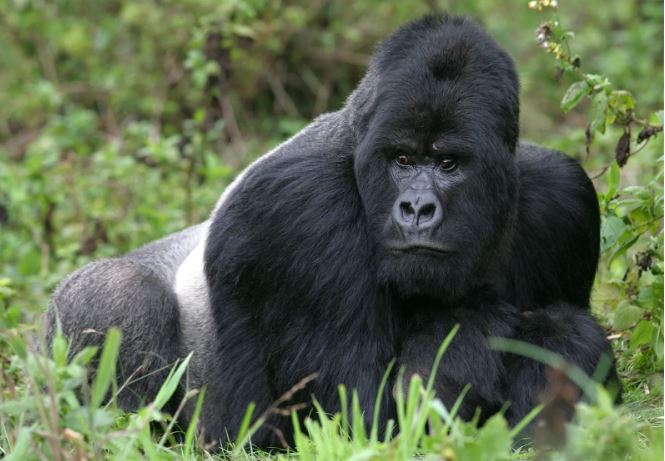


 6:47:10
6:47:10  2023-05-11
2023-05-11  999
999

Gorilla, (genus Gorilla), genus of primates containing the largest of the apes. Gorillas live only in tropical forest of equatorial Africa. Most authorities recognize two species and four subspecies. The western gorilla (Gorilla gorilla) is made up of two subspecies: the western lowland gorilla (G. gorilla gorilla), which inhabits the lowland rainforests from Cameroon to the Congo river, and the Cross River gorilla (G. gorilla diehli), which inhabits a small forested region along the Cross River separating Nigeria from Cameroon. The eastern gorilla (G. beringei) is also made up of two subspecies: the eastern lowland, or Grauer’s, gorilla (G. beringei graueri), of the lowland rainforests of the Democratic republic of Congo (Kinshasa), and the mountain gorilla (G. beringei beringei), found in the montane rainforests and bamboo forests of the highland terrain north and east of Lake Kivu, near the borders of Uganda, Rwanda, and Congo (Kinshasa).
The gorilla is robust and powerful, with an extremely thick, strong chest and a protruding abdomen. Both skin and hair are black. The face has large nostrils, small ears, and prominent brow ridges. Adults have long, muscular arms that are 15–20 percent longer than the stocky legs. Males are about twice as heavy as females and may attain a height of about 1.7 meters (5.5 feet) and weight (in the wild) of 135–220 kg (300–485 pounds). Captive gorillas of both sexes may grow quite fat and hence become much heavier. A wild adult female typically is about 1.5 meters tall and weighs about 70–90 kg. Gorillas lack hair on the face, hands, and feet, and the chest of old males is bare. The hair of G. beringei beringei is longer than that of the other three subspecies. Adult males have a prominent crest on top of the skull and a “saddle” of gray or silver hairs on the lower part of the back—hence the term silverback, which is commonly used to refer to mature males. This saddle is much more conspicuous in eastern gorillas (G. beringei), which are jet black, than in western gorillas (G. gorilla), which are more of a deep gray-brown.
The gorilla is active during the day (diurnal) and primarily terrestrial, usually walking about on all four limbs with part of its weight supported on the knuckles of its hands. This mode of locomotion, called knuckle walking, is shared with chimpanzees. Occasionally gorillas stand erect, mainly when displaying. Females and young climb more than males, mainly because much vegetation cannot support the weight of males.
Their diet is vegetarian; that of eastern gorillas includes leaves, stalks, and shoots, but western gorillas eat much more fruit. Gorillas generally dislike water, but in some areas, such as the Sangha-Ndoki region on the borders of Cameroon, the Republic of the Congo (Brazzaville), and the Central African Republic, they wade waist-deep into swampy clearings to feed on aquatic plants. Gorillas spend much of their time foraging and resting, with the group traveling a few hundred meters between several daily feeding bouts. Each group wanders through a home range of about 2–40 square km (0.77–16 square miles), though several different groups may share the same part of the forest. At dusk each gorilla builds its own crude sleeping nest by bending branches and foliage. A new nest is built every night either on the ground or in the trees.
Reality Of Islam |
|

A new NURBS

A research

Researchers
 9:3:43
9:3:43
 2018-11-05
2018-11-05
10 benefits of Marriage in Islam
 7:5:22
7:5:22
 2019-04-08
2019-04-08
benefits of reciting surat yunus, hud &
 9:45:7
9:45:7
 2018-12-24
2018-12-24
advantages & disadvantages of divorce
 11:35:12
11:35:12
 2018-06-10
2018-06-10
 6:0:51
6:0:51
 2018-10-16
2018-10-16
 7:45:39
7:45:39
 2018-06-21
2018-06-21
 2:5:14
2:5:14
 2023-01-28
2023-01-28
 10:47:11
10:47:11
 2022-11-22
2022-11-22
 1:38:41
1:38:41
 2021-12-08
2021-12-08
 6:0:8
6:0:8
 2023-03-19
2023-03-19
 2:11:12
2:11:12
 2022-10-15
2022-10-15
 7:34:7
7:34:7
 2023-02-28
2023-02-28
 5:41:46
5:41:46
 2023-03-18
2023-03-18
| LATEST |